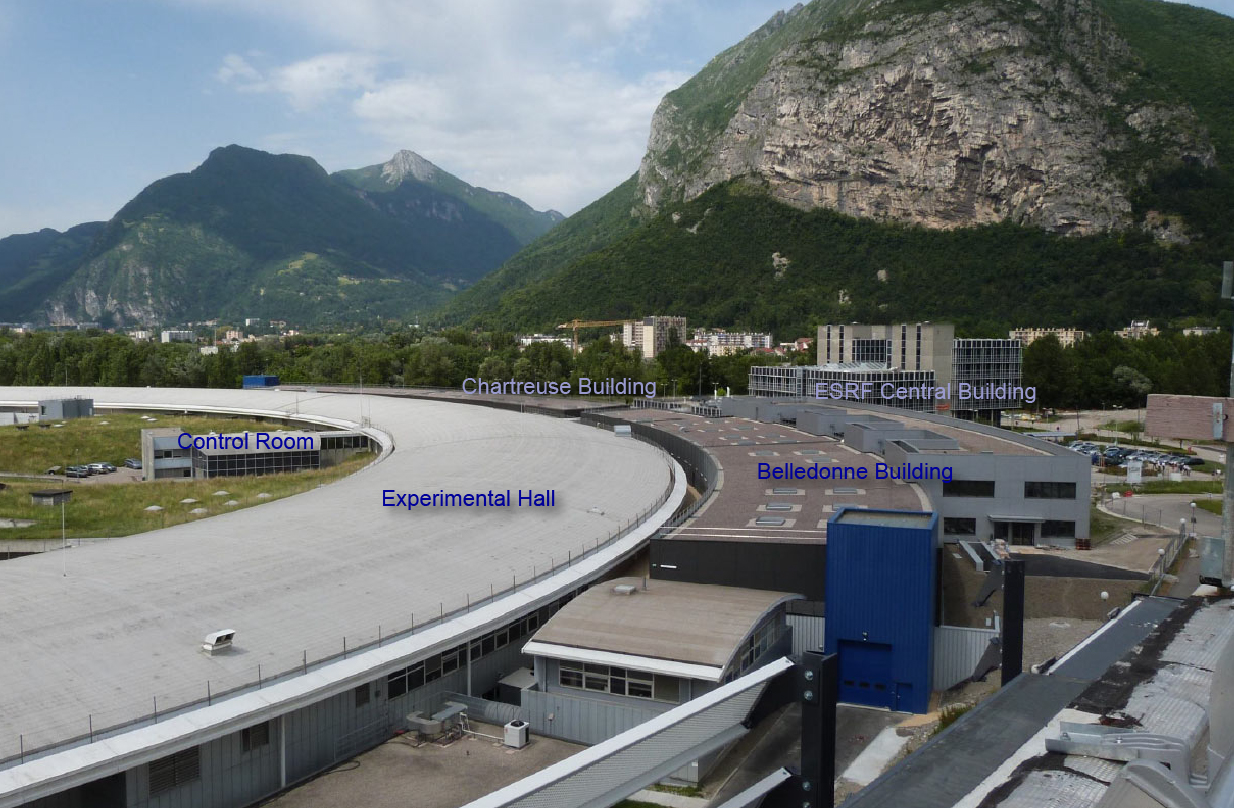- Home
- News
- General News
- ESRF inaugurates...
ESRF inaugurates new experimental halls
26-06-2013
On Monday, 24th June the ESRF inaugurated the two new experimental halls built to house extended beamlines, laboratories and offices as part of the Upgrade Programme. Just 19 months after the ground-breaking ceremony, the new buildings have been completed on schedule and within budget. The ESRF Council Chairman, Jean Moulin, and Director General, Francesco Sette, headed the ribbon-cutting ceremony.
Share
Coinciding with the 59th meeting of the ESRF Council, the ceremony assembled Council members, staff involved in the project and officials from the contracting companies. Ten pairs of scissors were required for the impressive line-up that cut the ceremonial band.
ESRF Council Chairman, Jean Moulin (centre) and Francesco Sette (centre left) among the Directors and Project Managers during the ribbon cutting ceremony.
Belledonne and Chartreuse Experimental Halls
The two new buildings, named Belledonne and Chartreuse after the mountain ranges they face, constitute an extension of the existing Experimental Hall and are a major part of the ESRF upgrade programme, phase I.
The Belledonne building, where guests gathered for the inauguration ceremony, is a three-storey edifice providing almost 3400 m2 of useable space. It will house four extended beamlines (ID31, ID32, ID01, ID02) and laboratories on the ground floor with offices and a cafeteria on the other two levels. The first floor will also accommodate the Visitor Centre scheduled to open this autumn.
The smaller Chartreuse building, on the northern side, will house the ID30-B beamline dedicated to Macromolecular crystallography. Hutch construction has already started here and user operation is scheduled for spring 2014.
Beamlines are getting longer and longer
As part of the Upgrade, several ESRF beamlines are being extended to adapt to the evolution of scientific demands for nano-capable and high resolution experimental stations.
The first beamline in the series to undergo extension is ID16 which will become the ESRF’s longest beamline, with one end-station positioned 200m from the source.The first step of the EX2 programme saw the completion and subsequent inauguration of the satellite building in October 2012. This building will house the two end stations and offices. ID16, also called NINA, is a doubled-branched beamline that will cater for nano-imaging (NI) and nano-analysis (NA) for biological, biomedical, cultural-heritage and environmental applications from December 2014.
A building like no other
The prime contractor competition for EX2 debuted in 2008 and was finally awarded to architects Sechaud & Bossuyt in 2009. Bids for the construction were received mid 2011 and works started with the demolition of existing buildings in December 2011. Construction of the Belledonne and Chartreuse buildings started in February 2012.

An overview of the Chartreuse and Belledonne constructions that embrace the curve of the original Experimental Hall.
Many constraints were imposed on the construction of EX2. For example, each building had to be floored with a monolithic high quality slab with high static and dynamic stability and no amplification of background vibrations. Throughout the works, the site remained operational and strict safety regulations were put into place to guarantee personnel security and circulation amidst the heavy works.
The new buildings have been built in respect of the environment with 6000 m2 of green roofs, environmentally friendly building materials, air-tight buildings and rain-water recuperation.
Five months without beam
The ESRF was forced into a five-month shutdown of the accelerator complex, too sensitive to counter the ground vibrations induced by the works. More than 50 000 tons of earth were excavated during the construction works. The sanction was direct with a large impact on the alignment of the experimental hall. During normal operation, the storage ring and experimental hall are carefully monitored to maintain all equipment aligned to within +/- 500 µm over a year. During the works, ground movements were increased by a factor of five within the space of one month.
Along with extensive maintenance operations, major upgrades inside the storage ring and accelerator tunnels were implemented during this period (straight section extensions, installation of 6m vacuum vessels, canted magnets for double branched beamlines, RF upgrade, etc.). Despite the disruption and the longest shutdown in the history of the ESRF, the accelerators were restarted successfully on 19th April 2012.
Related articles
Ground-breaking ceremony - 29 November 2011
Golden slab for experimental halls
ESRF Upgrade Programme
Text by Kirstin Colvin
Top image: Officially open ... the experimental halls are now the scene of construction works for the beamlines, offices and labs they will house.



